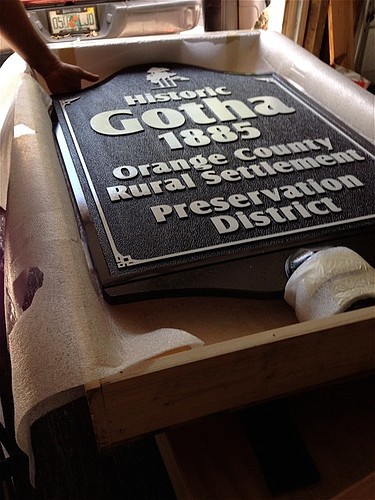- April 25, 2024
-
-
Loading

Loading

Kathleen Klare always has been passionate about history, but a years-long quest to learn everything she can about Gotha has led her on a journey of preservation for the small West Orange community.
“I have a strong interest in preservation, and this is my way of preserving an area that deserves to be talked about,” she said.
Klare might be a Windermere resident now, but her roots are in Gotha. Her family settled there in 1911, and she was raised in Gotha.
“Ever since I came back from Washington, D.C., in 2003, I’ve been involved with Gotha,” she said.
She joined the Henry Nehrling Society, as well.
“Dr. Nehrling was a very good writer who documented a lot of good things about Gotha, … and that’s what got me interested,” Klare said. “I’m just trying to preserve (its history). I have been able to date Gotha back to 1786. It was founded in 1885. History is about following. You don’t create it; you go where it leads you. It’s the thrill of the hunt.”
She is the community’s historian and a board member of the Gotha Rural Settlement Association. Her latest title is project manager and designer for the Gotha Historic Sign project.
Looking to find a way to identify Gotha’s rural settlement, Klare designed seven historic entry signs that will be placed strategically around the perimeter of Gotha’s preservation district.
The signs are finished, she said, and the Gotha Rural Settlement Association is waiting for Orange County to install them.
The signs are needed because so few people know about Gotha and its unique history, Klare said. For instance, it was one of only two German colonies in the state of Florida.
Klare suspects many people see Gotha as a means to get from one place to another, and she’s hoping the signs will bring some respect for the community.
Orange County’s District 1 Commissioner Betsy VanderLey secured grant monies through the county’s Neighborhood Preservation and Revitalization Office to pay for the project.
Klare said the signs cost about $23,000, which included the installation.
“We’re going to have a big party when they’re installed to acknowledge all the people involved, especially the county,” she said.
GOTHA'S PAST
Gotha was established in 1885 when Henry A. Hempel came to the area with the plan of forming a German town. He encouraged northerners to resettle in the area he named Gotha — in honor of his birthplace in East Germany.
The main street through Gotha is named for the settler.
Between 1885 and 1896, ornithologist and horticulturist Henry Nehrling bought 65 acres and established a 25-acre garden, which he named Palm Cottage Gardens. In the early 1900s, this is where Dr. Nehrling tested more than 3,000 plants.
In 1999, the Henry Nehrling Society was organized as a non-profit corporation to save this important piece of Florida’s pioneer history. His 1880s wood-frame home has been preserved on the six remaining acres of his garden.
The property was placed on the National Register of Historic Sites in 2000.
Nine years later, the society purchased the property to preserve the home and remaining historic gar
dens and to create an education center and community resource focusing on historic preservation, horticultural education and environmental conservation.
In 2013, the official Florida Heritage Landmark marker was installed.
Zion Lutheran Church was established between 1887 and 1894 on what is now Morton Jones Road. After the first building burned down, a new church was constructed at Hempel Avenue and Gotha Road sometime after the turn of the century. It still stands today.
Severe freezes in 1894 and 1895 destroyed most of the citrus groves that were planted by northerners who had made Gotha their home, and many of the families left.
Hempel filed a plat for Gotha with Orange County, but the community never incorporated.
In its heyday, the West Orange County settlement had schools, churches, a railroad, social hall and sawmill.
In 1992, Orange County amended its charter to allow the designation of rural settlements as preservation districts; the Gotha Rural Settlement was then established. In 1995, it was designated as a historic preservation district.